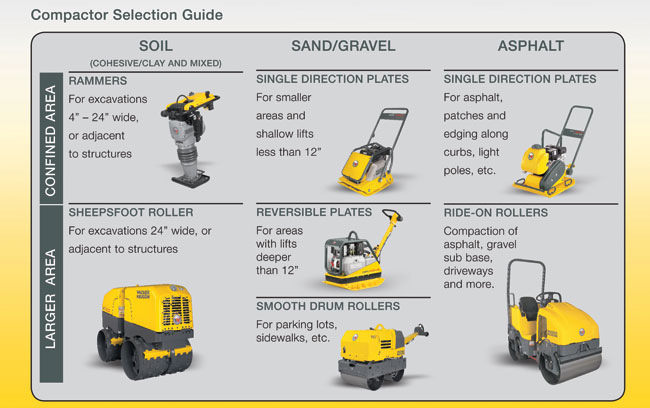Base of Support
There are many types of compaction equipment and each is designed for different applications. Before the selection process begins, it may help to understand the basics of soil compaction. Soil compaction is a conditioning or compacting of soil beneath or next to construction. In a sense, it is preventive maintenance. Properly done, soil compaction will eliminate settling, cracking or heaving of drives, walks, floors, walls, foundations and everything in between.

Technically, soil compaction is the removal of air voids from the soil by applied force. The result is a denser soil with the ability to hold greater weight. The natural ability of soil to support a structure becomes altered during excavation. Its density changes and some soils become exposed. Mechanical soil compaction accelerates the natural process of the soil settling and in some cases makes construction possible on marginal building sites.
The effects of inadequate soil preparation may take weeks or even years to become apparent. However, once the results begin to show, the costs of repairs far outweigh the time and rental costs of proper soil compaction the first time around. Choosing the correct method of compaction is as important as the compaction itself. To make the selection process easier, rental center operators should ask customers three basic questions. Answers to these questions should give enough information to select the right machine for the job.
- What type of soil needs to be compacted?
- What are the compaction specifications?
- What is the application or jobsite conditions?
Let’s start with the type of soil to be compacted. Proper soil identification is crucial when determining which type of compaction equipment is best for the job. Soil is classified into two main categories: granular and cohesive.
Granular soils consist mainly of sand and gravel. The particles are coarse and large enough to see with the naked eye. When granular soil is wet, it may be molded but will crumble easily. Granular soils are best compacted with vibration energy. The type of machine would be either a vibratory plate or vibratory roller. The vibration action reduces the frictional forces at the contact surfaces, allowing the particles to fall freely under their own weight. At the same time, as the soil particles are vibrating, they become momentarily separated
from each other, allowing them to turn and twist until they can find a position that limits their movement.
Cohesive soils are made up of silts and clays. The grains are very small and feel smooth when rubbed between your fingers. When wet, cohesive soils are sticky and can be molded or rolled into almost any shape. When dry, this soil type tends to be very hard and difficult to crumble. Cohesive soils are best compacted by impact force. The type of machine recommended is a vibratory rammer or sheepsfoot roller. The impact force of the rammer or sheepsfoot roller causes a shearing effect that squeezes out air voids and excess water from between the particles.
What Are the Compaction Specifications?
Along with the type of soil being compacted, the method of compaction used is largely determined by the job specifications that need to be met. Machine selection is often dictated by compaction specifications. The most common specifications include lift, or soil depth/layers, and the number of passes made with the machine to achieve optimum compaction. The machine selected should have enough power to compact the soil to the depth required. If the machine does not have enough power, the proper density will not be reached. If it has too much, over-compaction can occur. This is the result of excessive passes or too much power on too thin a soil layer. How many passes? This will vary with the situation, but the following guideline will attain 95 to 100 percent Standard Proctor density. Use three passes for a rammer, four for a vibratory plate and five for a vibratory roller.

What Is the Application or Jobsite Condition?
The actual jobsite is an important factor when selecting equipment. In general, vibratory plates are more efficient than rollers due to the large baseplate surface area in contact with the soil. Vibratory plates are also more maneuverable so they are ideal for confined areas. Rollers have the advantage in larger, open areas where there is plenty of room to maneuver. Because the roller has a fast travel speed, it will cover the area faster than a plate. The same logic applies to rammers. The rammer should be used on cohesive soils in confined areas and the trench roller should be used in larger trenches and open areas.
Fred Paul is a sales engineering manager with Wacker Neuson Corp., based in Menomonee Falls, Wis.
